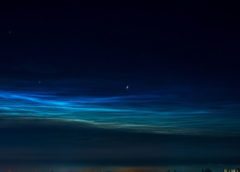There’s an electric blue glow in the skies above Antarctica. The strange glow is coming from noctilucent clouds. That’s according to recent images from NASA’s AIM spacecraft (Aeronomy of Ice in the Mesosphere), which monitors these clouds for the whole Earth.
The season for night-shining clouds in the Southern Hemisphere is November to April, so they are right on schedule. Night clouds or noctilucent clouds are tenuous cloud-like phenomena in the upper atmosphere. They are made of ice crystals and are only visible in a deep twilight.
Noctilucent roughly means night shining in Latin. They are most commonly observed in the summer months at latitudes between 50° and 70° north and south of the equator. These clouds can be observed only during local summer months and when the Sun is below the horizon for the observer, but while the clouds are still in sunlight. They are the highest clouds in Earth’s atmosphere, located in the mesosphere at altitudes of around 47 to 53 miles. They are too faint to be seen during daylight, and are visible only when illuminated by sunlight from below the horizon while the lower layers of the atmosphere are in the Earth’s shadow.
These clouds are made of ice crystals, and are seeded by fine debris from disintegrating meteors. Noctilucent clouds are not fully understood and are a recently discovered meteorological phenomenon, They can form only under very restricted conditions during local summer; their occurrence can be used as a sensitive guide to changes in the upper atmosphere. They are a relatively recent classification. The occurrence of noctilucent clouds appears to be increasing in frequency, brightness and extent.
Check out these articles:
https://www.nasa.gov/mission_pages/aim/mystery_clouds_multi.html


